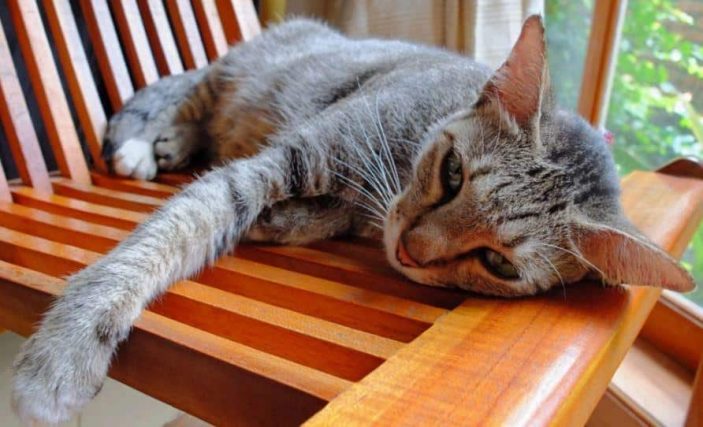We highlighted vitamin D roles, amounts required and deficiency symptoms where we noted some roles which include not only helping in the absorption of calcium and phosphate but also balancing it. It also plays a role in the control of muscle and nerve as well as bone formation.
On the other hand, deficiencies cause a number of symptoms including softening of bones, rickets, ataxia, heart failure among others.
Although researchers have predicted higher chances of cat survival if it has higher vitamin D than those with lower amounts. This does not mean excessive amounts are any safe!
Let us focus on hypervitaminosis D which results from excessive consumption of this vitamin, its symptoms, the diagnostic procedures your vet may conduct in detecting it as well as treatments and prevention options he or she may recommend.

Causes
The toxicity arises from excessive intake of vitamin D, especially the D2 (cholecalciferol) and D3 (ergocalciferol) but other of its vitamers may be involved too. How does it happen?
- Ingesting rodent poisons or rodenticides with this vitamin such as Ceva True Grit Rampage, Mouse-B-Gone, Muritan, Quintox Rat and Mouse Bait, Quintox Mouse Seed, among others as well as ingesting a poisoned rodent or toxic plants such as Risetum flavescens, Cestrum diurnum (Jessamine).
- Secondly, this can possibly happen through poor diets which involves ingesting large amounts of foods high in this vitamin such as fish, milk, eggs, and liver or food supplements containing an excess amount of this vitamin.
- Finally, your feline friend may accidentally ingest human medicines that have high amounts of vitamin D such as those for treating “osteoporosis, osteomalacia, hypoparathyroidism, and hypophosphatemic disorders” notes Wag! as well as some creams such as psoriasis creams.
Although this poisoning can affect cats of all ages, kittens, those predisposed to hyperparathyroidism or kidney failure have been found to be more susceptible.
Symptoms to expect
If a cat ingests too much of vitamin D than required, it is likely to suffer from both hypercalcemia and hyperphosphatemia – high blood calcium and phosphate levels respectively.
Hypercalcemia will lead to soft tissue calcification including kidneys, artery walls, lungs and intestinal tract as well as skeletal abnormalities, kidney failure, GI and cardiac upsets and so on.
Symptoms noted will depend on the severity of the poisoning and they may be noted after 12-48 hours duration and they will include:
- Weakness or fatigue
- Vomiting including blood
- Depression
- Lack of appetite
- Polydipsia – he or she will become more thirsty
- Polyuria or increased urination
- Constipation
- Dark tarry bloody feces
- Weight loss
- Excessive salivation or drooling
- Seizures
- Muscle tremors
- Abdominal pains
- Lung hemorrhage
If not attended to in time, your cat may end up with kidney stones and failure, mineralization of some organs, extreme bone loss, among other symptoms.
Diagnosis
Your vet will want to know more about your feline friend’s diet, supplements that are being given, a possibility of access to rodent poisons, and so on.
Afterward, he or she may consider complete blood count, an electrolyte analysis, a biochemical profile and analyze your cat’s urine (urinalysis).
Extremely low potassium in the blood, abnormally high levels of phosphorous and calcium or too much urea in a biochemical profile may indicate vitamin D poisoning. Some cats will reveal a low albumin protein in the blood and extremely high enzymes in their liver from their biochemistry profile.
Note that in the biochemical profile, a high BUN (blood, urea nitrogen) level could be indicating kidney failure.
The toxicity may also be indicated by urinalysis if calcium, glucose and protein levels are abnormally high while bleeding from some organs or body sites will indicate platelet levels have gone so low.
If your vet suspects excessive bone loss or organ mineralization, he or she may consider radiographs where an X-ray will be vital in revealing this bone loss or organ mineralization.
Finally, a more concrete way to be certain that vitamin D toxicity is the cause will involve testing for their level in blood and an echocardiogram (ECG) for evaluating your pet’s heart status for things such as slow heartbeat and other abnormalities.
Treatments
Hypervitaminosis D requires immediate medical attention and hospitalization. How soon it is treated will determine whether your pet’s life will be saved or not. Some treatment consideration by your veterinarian may include the following:
- Inducing vomiting and giving medications that bind with vitamin D to stop any further absorption if it happened not long ago such as belong six hours.
- Prescription of various medications including phosphate binders (like Vetoquinol Epakitin), anti-vomiting, calcitonin (to help stop bone loss), diuretics (such as furosemide to help increase calcium excretion), prednisolone (to increase kidney calcium excretion while reducing intestinal and bone absorption of calcium), and so on.
- IV fluid therapy for rehydration and rebalance electrolytes as well as increase urination to excrete the high calcium amounts.
- Anti-seizure medication in case your cat has seizures, blood transfusion if it has become anemic and antibiotic therapy to minimizes chances of secondary bacterial infections common after this toxicity.
- Vitamin K injections to help promote blood coagulation in case bleeding sites noted.
Prolonged hospitalization to monitor the efficacy of treatment therapy and regular testing may be required making treatment quite expensive.
In some cases, the VCAhospitals.com states that “some cats may have long-term impairments, such as kidney disease, heart disease, or gastrointestinal disease, and these complications from vitamin-D poisoning will need life-long management.”
Prevention
Do away with potential cause we have looked at including avoiding over-supplemented feeds, those high in vitamin D, rodenticides, some human medications including creams, and so on.
Finally, do not let your cats hunt as they can eat poisoned mice or rats. Instead, they should depend on the well-balanced diets you are giving them.
